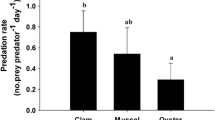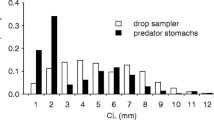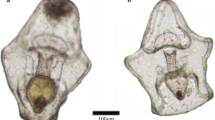Abstract
The objective of this study is to document under both field and laboratory conditions the phenomenon of size-biased feeding by the Gila topminnow, Poeciliopsis occidentalis, and to shed light on the mechanisms responsible for this process. Adult female Gila topminnows feed in Monkey Spring, Santa Cruz County, Arizona, on a variety of food items, but Hyalella azteca is an important element of its invertebrate diet. The size of the amphipods ingested by female topminnows is a function of the size of the fish, with larger fish taking larger prey. There is also a strong preference for topminnows to select large amphipods from within the size limits imposed by the width of the mouth.
The correlation between fish size and prey size was also seen in the laboratory, utilizing Daphnia similis and food pellets as prey. The tendency to select large prey from a range of available sizes was prominent with both Daphnia and pellets. The feeding period in the laboratory is characterized by two distinct phases. During the first phase, feeding is rapid and nonselective. As the feeding progresses, the rate of feeding drops dramatically and selectivity increases.
More complex laboratory feeding experiments gave equivocal results. When fish were presented pellets of two sizes at different densities and at different ratios of small to large, size biased feeding was not clearly evident. Both predator and prey densities, agonistic behavior, and reaction distance should be explored more thoroughly as next steps in attempts to mimic feeding behavior in nature.
Similar content being viewed by others
References
Archibald, C. P. 1975. Experimental observations on the effects of predation by goldfish (Carassius auratus) on the zooplankton of a small saline lake. J. Fish. Res. Board Can. 32: 1589–1594
Berg, A. & Grimaldi, E. 1965. Biologie delle due forme di Coregone (Coregonus sp.) del Lago Maggiore. Mem. Inst. Ital. Idrobiol. 18: 25–196.
Borutsky, E. V. 1939a. Dynamics of the biomass of Chironomus plumosus in the profundal of Lake Beloie. (Transl. from Russian) Proc. Kossino Limnol. Stat., Hydrometerol. Service, U.S.S.R. 22: 190–195.
Borutsky, E. V. 1939b. Dynamics of the total benthic biomass in the profundal of Lake Beloie. (Transl. from Russian) Proc. Kossino Limnol. Stat., Hydrometerol. Service, U.S.S.R. 22: 196–218.
Braum, E. 1964. Experimentelle Untersuchungen zur ersten Nahrungsaufnahme and Biologie an Jungfischen von Blaufelchen (Coregonus wartmanni Bloch), Weibfelchen (Coregonus fera Jurine) and Hechten (Esox lucius L.) Arch. Hydrobiol. Suppl. 28: 183–244.
Brooks, J. L. & Dodson, S. I. 1965. Predation, body size and composition of plankton. Science 150: 28–34.
Cummins, D. W. & Wuycheck, J. C. 1971. Calorific equivalents for investigations in ecological energetics. Mitteilungen Int. Verein. Theoret. angew. Limnol. 18: 1–158.
Doble, B. D. & Eggers, D. M. 1978. Diel feeding chronology, rate of gastric evacuation, daily ration, and prey selectivity in Lake Washington juvenile sockeye salmon (Oncorhynchus nerka). Trans. Am. Fish. Soc. 107 (1): 36–45.
Gerking, S. D. 1962. Production and food utilization in a population of bluegill sunfish. Ecol. Monogr. 32: 31–78.
Galbraith, M. C., Jr. 1967. Size-selective predation on Daphnia by rainbow trout and yellow perch. Trans. Am. Fish. Soc. 96: 1–10.
Hall, D. J., Cooper, W. E. & Werner, E. E. 1970. An experimental approach to the production dynamics and structure of freshwater animal communities. Limnol. Oceanogr. 15: 839–928.
Hrbáček, J. 1962. Species composition and the amount of zooplankton in relation to the fish stock. Rozpr. Cesk, Akad. Ved. Rada. Mat. Prir, Ved. 72: 1–116.
Hrbácěk, J., Dvorakova, M., Korinek, V. & Prochazkova, L. 1961. Demonstration of the effect of the fish stock on the species composition of zooplankton and their intensity of metabolism of the whole plankton association. Verh. Internal. Verein. Limnol. 14: 192–195.
Hurlebert, S. H., Zedler, J. & Fairbanks, D. 1972. Ecosystem alteration by mosquitofish (Gambusia affinis) predation. Science 175: 639–641.
Ivlev, V. S. 1961. Experimental ecology of the feeding of fishes. Yale Univ. Press, New Haven, Conn.
Janssen, J. 1976. Feeding modes and prey size selection in the alewife (Alosa pseudoharengus). J. Fish. Res. Board Can. 33: 1972–1975.
Lindstrom, T. 1955. On the relationship of fish size-food size. Rep. Inst. Freshwater Res., Drottingholm 36: 133–147.
Mann, K. H. 1964. The pattern of energy flow in the fish and invertebrate fauna of the River Thames. Verh. Internat. Verein. Limnol. 15: 485–495.
Nilsson, N. A. & Pejler, B. 1973. On the relationship between fish fauna and zooplankton composition in North Swedish Lakes. Rep. Inst. Freshwater Res., Drottningholm 53: 51–77.
Parker, R. R. 1971. Size selective predation among juvenile salmonid fishes in a British Columbia inlet. J. Fish. Res. Board Can. 28: 1503–1510.
Repsys, A. J., Applegate, R. L. & Hales, D. C. 1976. Food and food selectivity of the black bullhead, Ictalurus melas, in Lake Poinsett, South Dakota. J. Fish. Res. Board Can. 33: 768–775.
Ware, D. M. 1972. Predation by rainbow trout (Salmo gairdneri): the influence of hunger, prey density, and prey size. J. Fish. Res. Board Can. 29: 1193–1201.
Wells, L. 1970. Effects of alewife predation on zooplankton populations in Lake Michigan. Limnol. Oceanogr. 15: 556–565.
Werner, E. E. & Hall, D. J. 1974. Optimal foraging and the size selection of prey by the bluegill sunfish (Lepomis macrochirus). Ecology 55: 1042–1052.
Wong, B. & Ward, F. J. 1972. Size selection of Daphnia pulicaria by yellow perch (Perca flavescens) fry in West Blue Lake, Manitoba. J. Fish. Res. Board Can. 29: 1761–1764.
Zaret, T. M. 1972. Predator-prey interaction in a tropical lacustrine ecosystem. Ecology 53: 234–257
Author information
Authors and Affiliations
Additional information
Extracted from a Ph. D. thesis written by the junior author
Rights and permissions
About this article
Cite this article
Gerking, S.D., Plantz, D.V. Size-biased predation by the gila topminnow poeciliopsis occidentalis (Baird and Girard). Hydrobiologia 72, 179–191 (1980). https://doi.org/10.1007/BF00016245
Issue Date:
DOI: https://doi.org/10.1007/BF00016245




